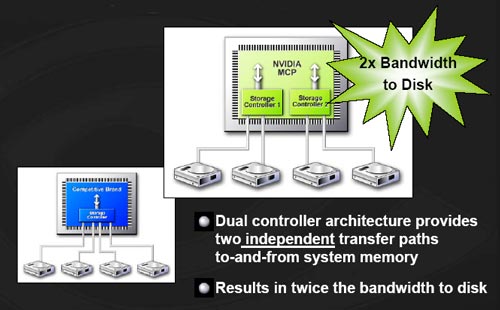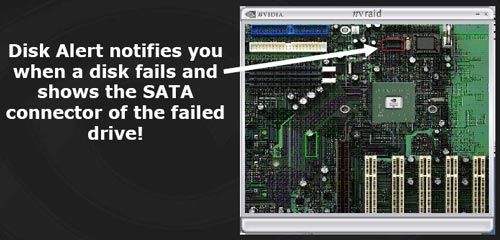nForce4: PCI Express and SLI for Athlon 64
by Wesley Fink on October 19, 2004 12:01 AM EST- Posted in
- CPUs
3Gb/s SATA
nVidia pioneered "any drive" integrated RAID capabilities with the nForce3-250 chipset. This included support for 4 SATA drives and 4 PATA drives that could be combined in RAID 0, 1, and 0+1 configurations. For nForce4, nVidia has taken SATA support even further by providing two independent SATA controllers on the nForce 4 Ultra and nForce4 SLI chipsets.
The Dual SATA controllers on the nF4 also support the upcoming 3Gb/sec SATA drives, which are now sampling. The new 3Gb/s SATA drives should start appearing in the market around the end of the year, which will provide nForce4 users with an upgrade path to improved hard drive performance. The nForce4 also supports drives with NCQ (Native Command Queuing).
Cross-Controller RAID
The unique cross-controller RAID is continued in the nForce4 chipset. This means that both Serial ATA (SATA) and parallel ATA disk devices can be combined within a single RAID array. Users don't need to worry about whether hard drives are SATA or IDE - the nVidia RAID controller treats both IDE and SATA drives the same and allows them to be combined in any way in the RAID controller. A single setup procedure applies to all drives, which makes it possible to use all the storage devices available. Users can also expand the number of drives easily without worrying about whether the drive is IDE or SATA.Spare Disk Allocation
Corporate RAID users are accustomed to RAID arrays with "hot spares" and on-the-fly rebuilds, but those RAID 5 features have been an expensive addition to a home PC. If a disk fails, RAID 1 allows continuous operation by taking advantage of the mirrored data copy in the array. The nVidia RAID solution goes a step further and lets a user rebuild a new mirrored copy for the data while the system is up and running, without disrupting user and application access to the data set. Rebuilding on the fly eliminates down time and maximizes protection for critical storage resources.The nVidia RAID controller allows the user to add hot spare features to a home PC that is running any type of mirroring on the nVidia RAID controllers. Users can designate spare drives that can be configured as hot standbys, protecting arrays in the event of a disk failure. A shared spare can protect multiple arrays of drives, or a dedicated spare can serve as a hot standby for a particular drive array. The spare disk feature, which offers protection that goes beyond mirroring data, has been traditionally limited to high-end RAID systems, but this feature is built into the nForce4 RAID controllers. This isn't RAID 5 on a home PC, but the flexibility and data protection capabilities are truly impressive.
Disk Alert
One of the clever options available with the nForce4 is a feature called Disk Alert. With the large number of drives supported on the nForce4, it is not always an easy task to determine which drive has failed in the event of a pulled cable or other drive problem.
Disk Alert pops up a picture of the motherboard and shows exactly which drive connection has failed. This is a really slick idea, but we are still dependent on motherboard manufacturers to supply an accurate picture or diagram to embed in the alert feature.
Morphing From One RAID Array to Another
Morphing is the ability to convert from one RAID mode to another RAID mode. This allows the user to upgrade their current disk or array for better performance, higher security, and increased capacity. More importantly, this is accomplished without having to go through multiple steps. The morphing feature gives the user an upgradeable option to manage storage easily.In a traditional RAID environment, when a user wants to change the current state of a disk or a current array to a new RAID configuration, reconfiguring the new array involves a number of steps. The user must back up the data, delete the array, re-boot the PC, and then reconfigure the new array. NVIDIA RAID allows the end user to change the current state of the disk or array to another with a one-step process called "Morphing".
In general, to morph a RAID, the new array capacity must be equal to or greater than the previous array. For example, it is possible to morph from a RAID 1 array to a RAID 0 array as long as the RAID 0 array is the same size as (or larger than) the RAID 1 array. There are some limitations to RAID morphing, however. You can't morph to or from a JBOD (Spanning) array, from RAID 1 to RAID 1, or from RAID 0+1 to RAID 1.










101 Comments
View All Comments
suave3747 - Wednesday, October 20, 2004 - link
#70According to nVidia's website regarding the nForce 4 SLI, it states that the board will have 20 lanes of PCIe. It also states that there will be 3 PCIe 1x slots. I assume that the SLI board will have the option of using 1 PCIe 16x and 3 PCIe 1x slots, or 2 PCIe 8x slots and 3 PCIe 1x slots. Therefore, there is really no "lack" of PCIe 1x slots on the board. That board pictured was probably just a poor representation of the actual retail board.
The thing I am curious to know is whether there will be a reasonable amount of standard PCI slots available for use until PCIe cards for sound and whatnot become more prevalent.
stelleg151 - Wednesday, October 20, 2004 - link
Wesley, now that your done testing the board, if you need someone to take it off your hands I would be willing to take that burden.ThePlagiarmaster - Tuesday, October 19, 2004 - link
Wesley,I'm wondering why the dvd2avi divx 5.1.1 show such close results here. With basically the same machines on hardocp, they show the athlon64 beating Intel's best by HUGE margins (like 20% faster than the 3.6 and almost the same over the 3.4ee)
http://www.hardocp.com/article.html?art=Njc1LDM=
You guys showed the same thing no too long ago, but I can't find the article now. The paragraph under the graphs of the A64 winning said Intel lost the last thing they used to win in the benches. The article appears gone? What happened here, why so different from dvd2avi results at hardocp? They used the same divx 5.1.1 so it's not the encoder or the frontend. Heck even the 3500+ dominated the 3.6 and 3.4ee (more than 10%).
Whatever it is, I think a bit of research needs to be done on what's best for AMD, and what's best for Intel and pit them against each other. Clearly AMD people would run the way hardocp does (though it looks no different than what's used here). While you state you can show whatever you want, perhaps you should be showing the BEST for each platform. Would people really go home and run in a way that makes their cpu look like crap?
When you're talking about cutting 20% off of encoding, that adds up to a lot of time. I'd argue with the statement about divx 5.1.1 exploiting sse3 and making Intel a usual winner. Hardocp has been using 5.1.1 and A64's kill p4's with it (and have for a long time on their site). Is it AutoGK that throws things out of whack? Does it favor Intel so much that it causes a 20+ percent reversal? If it's truly based on dvd2avi how could it be so far out of whack compared to hardocp's scores? I think your readers would want to know which way to encode the fastest with whichever cpu they choose. Why would people want to know what the middle ground is and lose 20% cpu performance? Maybe Xmpeg for Intel, and pure dvd2avi for AMD?
Wesley Fink - Tuesday, October 19, 2004 - link
#73 -The earlier results are on on different test bed with a different video card. If you check out results on the same setup at http://www.anandtech.com/mb/showdoc.aspx?i=2128&am... you will see that the Asus is performing about the same as the other K8T800 boards. It is true that the nVidia nF3 and nF4 perform best with an nVidia card which we have pointed out many times in the past.
Saist - Tuesday, October 19, 2004 - link
just wanted to make a couple of comments:Nvidia's Soundstorm was a result of it's partnership with Microsoft and the Xbox. Since Nvidia is no longer being funded by Microsoft and is no longer involved with Xbox2, there is little reason from Nvidia's viewpoint to continue researching audio.
I also will state that if you are scared of Creative and you want more powerful audio. Get a freaking Via Envy chip. Those are only $20-$30 with shipping and match the Creative Offerings pretty nicely.
Saist - Tuesday, October 19, 2004 - link
Noli - Tuesday, October 19, 2004 - link
For all those disappointed with old AC97 codec sound chip on nf4, why not wait for via's K8T890 with better envy sound? (ok it's still not as good as soundstorm but it's better than AC97 right?). K8T890 also should have dual vid cards and also NCQ disk support... (but admittedly lacks ntune style bios extras).One thing I want to know is if K8T890 only supports nvidia SLI?? Presume so cause it's branded dual GFX. Would be awesome to be able to double up with less noisy ATI cards though. Also, seem to remember that Alienware's dual card solution was NOT SLI and seemed to produce consistent 90%+ frame rate improvements. Anyone know if/when this is coming out?! If so, 90%+ beats nvidia at their own game (and from a computer 'vendor' - ha!).
Disappointed that dual vid cards might be limited to nvidia - 6800GTs are good but still prefer ATI and 2 nvidia cards would prob be too noisy for me...
Spinne - Tuesday, October 19, 2004 - link
When will the nTune software be avaiable? NVidia's download site has a page for nTune, but the download link at the bottom still points to the old System Utility.Rza79 - Tuesday, October 19, 2004 - link
Correct me if i'm wrong but this how i see it:First check this review:
http://www.anandtech.com/cpuchipsets/showdoc.aspx?...
-------------------
Check the Business Winstone test scores:
nForce3 => 30.1
K8T800 => 28.9
Now this review:
nForce3 => 30.1
K8T800 => 26.9
---------------------
Now Multimedia Winstone:
nForce3 => 37.4
K8T800 => 36.9
In this review:
nForce3 => 36.9
K8T800 => 33.4
---------------------
This can't be right?
If the Asus board really performs this bad, then they should have taken another board.
It's harder to judge about the gaming test since they use a different card. Above that, Geforce cards tend to perform better on a nForce platform. So my guess is to have a fair review they should have used a ATI based card like the X800.
Second thing they always forget to mention is the Serial ATA driver for the Via board. I mean this can be an important factor.
I agree with post nr. 69 & 70.
Lately i'm starting to lose faith in reviews from Anandtech, just like i did with Tomhardware a couple of years ago. Seems like you can't get reliable reviews with the big review sites anymore.
Wesley Fink - Tuesday, October 19, 2004 - link
#70 -We will be rewiewing the K8T890 as soon as we receive a retail board. Thus far none have shipped.
The K8T890 reviews at other sites in September were based on a traveling preview board which VIA did not make available to all of the major review sites.